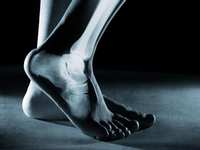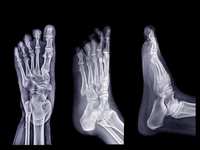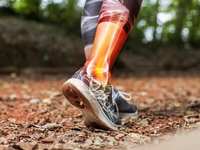Tips for Healthy Feet while Traveling

Health experts agree that travel is good for your mental and physical well-being with benefits that include improved heart health and lower stress levels, but exploring new places can also take a toll on your feet.
Long hours spent walking, standing, and sitting can lead to a variety of issues, from blisters and swelling to foot pain and fatigue.
“Your feet are your prime vehicle when traveling. The very action of travel has always — and hopefully always will — be based on walking,” says the travel website Vagabond Journey. “When in travel, a minor seeming and easy to ignore blister or abrasion on the foot can quickly turn into a debilitating wound or infection if quick action is not taken.”
Why Travel Stresses Your Feet
Our bodies crave routine and travel takes us out of those routines, especially for our feet.
From long journeys to unfamiliar environments, travel, by its very nature, puts unusual stresses on our feet:
- Increased Activity: Whether you're sightseeing or navigating airports, travel often involves more walking and standing than your usual routine. This puts extra strain on your feet and ankles. Your feet will quickly notice if you have gone from your normal workday of 4,000 steps to 14,000 on-the-go steps.
- Prolonged Sitting: Long journeys on planes, trains, or buses can restrict movement and blood flow, leading to swelling and stiffness.
- Unfamiliar Environments: Different terrains, uneven surfaces, and unfamiliar footwear can increase the risk of injuries and blisters.
- Changes in Hygiene: Public showers, pools, and shared footwear can expose your feet to bacteria and fungi, potentially leading to infections.
Of course, if you are going a long distance in the U.S. or globetrotting, then your long flight will put immediate stress on your feet.
“If you've ever slipped your shoes off during a long flight, you may have noticed that it's just a little bit harder to squeeze back into them on arrival. That's because it's extremely common for feet and ankles to swell — a condition technically known as "gravitational oedema"— when you fly,” says Travel+Leisure. “It's also a typically harmless phenomenon. The fact is, you have just been sitting too long — and all the liquids (i.e. blood) in your body have sunk to your feet.”
The dangers come when such swelling does not go down after a few hours after getting off your flight.
“Blood clots can sometimes form in your legs during air travel because you are immobile for long periods, often sitting in cramped spaces with little leg room. The clinical term for this type of blood clot is deep vein thrombosis (DVT). The longer the flight, the more at risk you are for developing a clot,” explains the American Society of Hematology.
Choosing the Right Footwear for Travel
We spend a lot of time choosing our travel destinations and carefully selecting how we will get there, our itineraries, and accommodations, but sometimes we neglect to choose the right footwear for travel.
You will want to plan for the right footwear for the plane, train, or automobile for your travel to your destination and then you will want the right footwear for your surroundings (Patagonia will be much different than Paris!) and for your daily outings (city sidewalks vs. hiking trails vs. seaside strolls).
“Picking the right shoes for travel can be a daunting task,” admits the Touch Style blog. “There are many factors to consider, from comfort and support to style and function.”
Here are some factors to consider when packing your suitcase:
- Supportive Shoes: Choose well-cushioned shoes with good arch support and a comfortable fit. Avoid new shoes (because you do not want blisters on your trip!) and break in any pairs you want to take before your trip. Don’t forget slip-on shoes for security checkpoints.
- Walking Shoes: Choose breathable, lightweight shoes with good traction for exploring new places.
- Hiking Boots: If you are exploring hiking trails or more rugged terrain, bring a pair of boots or hiking shoes with good ankle support and waterproof material.
- Flip-flops/Sandals: Pack flip-flops or sandals for showering and poolside use but avoid wearing them for extended periods. Many seasoned travelers never walk around their hotel rooms' carpet and flooring without slippers, sandals, or flip-flops on
- Compression Socks: Consider wearing compression socks during long journeys to improve circulation and reduce swelling.
Remember, choosing the right footwear depends on your specific travel itinerary and activities.
Essentials to Pack for Foot Care on the Go
In addition to footwear, make sure you pack essential foot care items when traveling such as:
- Moisture-wicking Socks: Pack enough breathable socks to change daily and prevent moisture buildup.
- Blister Pads and Bandages: Be prepared for unexpected blisters with adhesive bandages and moleskin.
- Foot Powder: Use antifungal powder to keep your feet dry and prevent athlete's foot.
- Moisturizer: Apply lotion at night to keep your feet hydrated and prevent cracking.
- Small First-aid Kit: Include basic supplies like antiseptic wipes, tweezers, and pain relievers.
Expecting the unexpected when on the go makes for happier traveling!
Dos and Don'ts for Healthy Feet While Traveling
Packing the right footwear and foot care essentials is a great first step to healthy travels. Once your trip has commenced, try these Dos and Don’ts to keep your feet happy:
Do
- Stretch and move regularly: Get up and walk around every few hours on long journeys. Perform simple foot exercises like ankle circles and toe stretches to improve circulation.
- Stay hydrated: Drink plenty of water throughout the day to prevent dehydration and swelling.
- Elevate your feet when possible: Prop your feet up on your luggage or a nearby seat during air travel or long car rides.
- Practice good hygiene: Wash your feet daily with soap and water, especially after using public facilities. Dry them thoroughly and avoid walking barefoot in shared spaces.
- Listen to your body: Take breaks when your feet feel tired, and don't push through pain.
Don't
- Wear tight or uncomfortable shoes: Always choose well-fitting, supportive footwear that allows your feet to breathe.
- Ignore foot pain: If you experience persistent pain, swelling, or discomfort, seek medical attention.
- Neglect foot care: Maintain your regular foot care routine, including washing, moisturizing, and checking for any signs of problems.
- Overdo it: Avoid excessive walking or strenuous activities, especially if your feet are not used to it.
Taking care of your feet is crucial for ensuring a comfortable and enjoyable travel experience.
If you experience foot problems after returning home, reach out to Sweeney Foot & Ankle Specialists for help with your foot or ankle pain or discomfort.


















